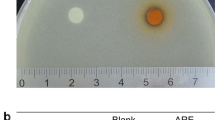Abstract
The effect of topical recombinant murine and human GM-CSF, 1 or 10 µg/cm2 for one to ten days, on the contraction and healing of acute and chronic granulating wounds infected withEscherichia coli was studied in Sprague-Dawley rats. Bacterial contamination of wounds produced significant inhibition of wound contraction. Application of GM-CSF at either dose level to infected wounds markedly increased the rate of wound closure compared to the rate in infected untreated controls. Ten days treatment was found to be more effective than a single application. An advanced stage of wound healing was observed at ten days in the GM-CSF-treated rats compared with controls. Bacterial counts decreased in the GM-CSF-treated wounds which may suggest bactericidal activity. Topical treatment with GM-CSF was shown to effectively inhibit the retardation of wound closure produced by bacterial contamination and may therefore be useful in the management of patients with infected wounds.
Similar content being viewed by others
References
Robson MC, Stenberg BD, Heggers JD Wound healing alterations caused by bacteria. Clinics in Plastic Surgery 1990, 3: 485–492.
Abercrombie M, Flint MH, James DW Wound contraction in relation to collagen formation in scorbutic guinea pigs. Journal of Embryology and Experimental Morphology 1956, 4: 167–175.
Robson MC, Raine T, Smith DJ, Heggers JP Principles of wound healing and repair. In: James E, Corry RJ, Perry JF (ed): Principles of basic surgical practice. Hanley and Belfus, Philadelphia, 1987, p. 61–72.
Grillo HC, Watts GT, Gross J Studies in wound healing. Contraction and the wound contents. Annals of Surgery 1958, 2: 145–169.
Cuthbertson AM Contraction of full thickness skin wounds in the rat. Surgery, Gynecology and Obstetrics 1967, 125: 131.
Van Winkle W Wound contraction. Surgery, Gynecology and Obstetrics 1967, 125: 131–142.
Vande Berg JD, Rudolph R Cultured myofibroblasts: a useful model to study wound contraction and pathological contracture. Annals of Plastic Surgery 1985, 2: 111–120.
McGrath MH, Simon RH Wound geometry and kinetics of wound contraction. Plastic and Reconstructive Surgery 1983, 72: 66–72.
Hayward PG, Robson MC Animal models of wound contraction. In: Barbul A, Caldwell M, Eaglstein W, Hunt T, Marshall D, Pines E, Skover G (ed): Clinical and experimental approaches to dermal and epidermal repair: normal and chronic wounds. Alan R. Liss, New York, 1991, p. 301–312.
Stenberg BD, Phillips LG, Hokanson JA, Heggers JP, Robson MC Effect of basic fibroblast growth factor on the inhibition of contraction caused by bacteria. Journal of Surgical Research 1991, 50: 47–50.
Hayward P, Hokanson J, Heggers J, Fiddes J, Klingbeil C, Geoger M, Robson M Fibroblast growth factor reverses the bacterial retardation of wound contraction. American Journal of Surgery 1992, 163: 288–293.
Hayward PG, Geldner P, Altrock B, Pierce G, Robson MC Granulocyte-macrophage colony stimulating factor in open wound healing. Surgical Forum 1990, 41: 621–623.
McCauley RL, Linares HA, Pelligrini V, Herndon DN, Robson MC, Heggers JP In vitro toxicity of topical antimicrobial agents to human fibroblasts. Journal of Surgical Research 1989, 46: 267–274.
McCauley RL, Li YY, Poole B, Evans MJ, Robson MC, Heggers JP, Herndon DN Differential inhibition of human-basel keratinocyte growth to silver sulfadiazine and mafenide acetate. Journal of Surgical Research 1992, 52: 276–285.
Metcalf D, Begley CG, Williamson DJ, Nice EC, De Lamarter J, Mermod JJ, Thatcher D, Schmidt A Hemopoietic responses in mice injected with purified recombinant murine GM-CSF. Experimental Hematology 1987, 15: 1–9.
Lopez AF, Nicola NA, Burgess AW, Metcalf D, Battye FL, Sewell W, Vadas MA Activation of granulocyte cytotoxic function by purified mouse colony-stimulating factors. Journal of Immunology 1983, 131: 2983–2988.
Wang JM, Colella S, Allavena P, Mantovani A Chemotactic activity of human recombinant granulocyte-macrophage colony stimulating factor. Immunology 1987, 60: 439–444.
Morrissey PJ, Bressler L, Charrier K, Alpert A Response of resident murine peritoneal macrophages to in vitro administration of granulocyte-macrophage colony stimulating factor. Journal of Immunology 1988, 140: 1910–1915.
Mayer P, Lam C, Obenaus H, Liehl E, Besemer J Recombinant human GM-CSF induces leukocytosis and activates peripheral blood polymorphonuclear neutrophils in nonhuman primates. Blood 1987, 70: 206–213.
Kucukcelebi A, Carp SS, Hayward PG, Po-Sheng H, Cowan WT, Ko F, Cooper DM, Robson MC Granulocyte-macrophage colony stimulating factor reverses the inhibition of wound contraction caused by bacterial contamination. Wounds 1992, 4: 241–247.
Heggers JP Variations on a theme. In: Heggers JP, Robson MC (ed): Quantitative bacteriology. Its role in the armamentarium of the surgeon. CRC Press, Boca Raton, 1991, p. 15–23.
Forrester JC, Zederfeldt BH, Hayes TL, Hunt TK Tape-closed and sutured wounds: a comparison by tensiometry and scanning electron microscopy. British Journal of Surgery 1970, 57: 729–734.
Crawford DT, Bains JW, andKetcham AS A standard model for tensiometric studies. Journal of Surgical Research 1965, 5: 265.
Weisbart RH, Golde DW, Gasson JC Biosynthetic human GM-CSF modulates the number and affinity of neutrophil f-Met-Leu-Phe receptors. Journal of Immunology 1985, 137: 3584–3587.
Perry AW, Sutkin HS, Gottlieb LJ, Stadelmann WK, Krizek TJ Skin graft survival: the bacterial answer. Annals of Plastic Surgery 1989, 22: 479–483.
Dunphy J The cut gut. American Journal of Surgery 1970, 119: 1–8.
Niinikoski J, Grislis G, Hunt TK Respiratory gas tensions and collagen in infected wounds. Annals of Surgery 1972, 175: 588–593.
Reed SG, Nathan CF, Pihl DL, Rodricks P, Shanebeck K, Conlon PJ, Grabstein KH Recombinant granulocyte/macrophage colony-stimulating factor activates macrophages to inhibitTrypansoma cruzi and release hydrogen peroxide. Comparison with interferon-γ. Journal of Experimental Medicine 1987, 166: 1734–1746.
Weiser WY, Van Niel A, Clark SC, David JR, Remold HG Recombinant human granulocyte/macrophage colony stimulating factor activates intracellular killing ofLeishmania donovani by human monocyte-derived macrophages. Journal of Experimental Medicine 1987, 166: 1436–1446.
Author information
Authors and Affiliations
Rights and permissions
About this article
Cite this article
Robson, M., Kucukcelebi, A., Carp, S.S. et al. Effects of granulocyte-macrophage colony-stimulating factor on wound contraction. Eur. J. Clin. Microbiol. Infect. Dis. 13 (Suppl 2), S41–S46 (1994). https://doi.org/10.1007/BF01973601
Issue Date:
DOI: https://doi.org/10.1007/BF01973601




